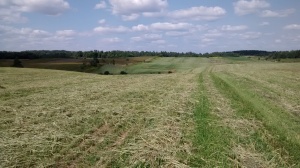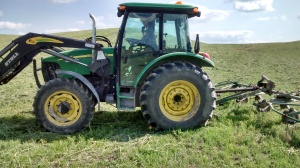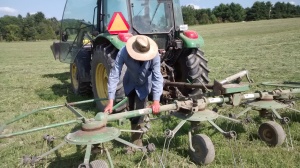One should make hay when the sun shines, so in a fencing lull, with our eye on the weekly forecast, we went about making plans to cut, ted, rake, and bale a few pastures. We figured we’d need around eight hundred bales to feed the cow-calf pairs through the winter and both Paul and Josée were getting pretty anxious seeing the neighbours hauling cart after cart of luscious golden hay, so the time was ripe.
We were hoping to harvest at least a hundred bales and needed at least four consecutive days of sun and warmth to get the job done. The thermostat was to be in the 30s for a solid mid-week and the sun was set to shine. We embarked. Hay making means long 16+ hour days, endless hours bumping along in a tractor, and being quite obsessed about listening to weather reports.
When Paul started talking about « entering hay season », the team* was pretty stoked to partake in this true farm experience. Turns out it’s a lot of taking over someone else’s house chores (cooking, milking, etc.) and not that much excitement. Regardless, all of those who wanted tractor shifts got a kick at the can.
(* At this point, the farm team had grown to welcome Thulasy and Graham, good friends visiting from Alberta. For a glorious month we were five adults and two toddlers on the farm.)
Here’s the hay tedder. The teeth spin to aerate and spread the grasses out, or to « wuffle » the hay, to expose more of the cut to sunlight, air and wind and thus speed up the hay-making process.
And here’s the awesome warning sticker on the tedder. The words, if there were any, have rubbed off, but that twirly body says it all.
All kidding aside, farm fatalities due to entanglement in machinery are real and frequent. Between 1990 and 2008, 1,978 accidental agricultural deaths were recorded in Canada. 70% were caused by machinery. 48% were caused by rollovers, runovers and entanglements (see report here).
Despite five solid days of heat and sun, the humidity and stillness of the air did us in. On the sixth day it poured. It rained like it hadn’t in months. Paul managed to bale 30 solid bales of dry stuff, 50 of moist, and the rest is still (rotting) in the fields a week later. Quite deflating. In cities, you just don’t have that sort of experience. Prior to living on the farm (and as an urban worker and dweller), Josée’s closest experience is probably when a day or two of freezing rain in February ruins the ice on the Rideau Canal and the city closes the skateway for the season despite an upcoming cold snap. It had never been about livelihood for her. And these failed bales totally are.
Here’s Paul rolling in with the dry bales in the pouring rain.
We’re going to be giving it another go in September and undoubtedly buying hay for our first winter.






